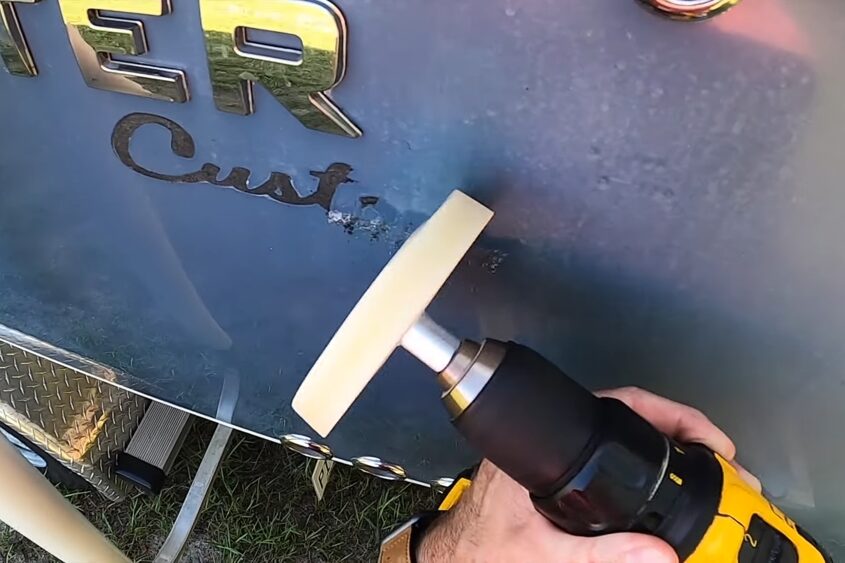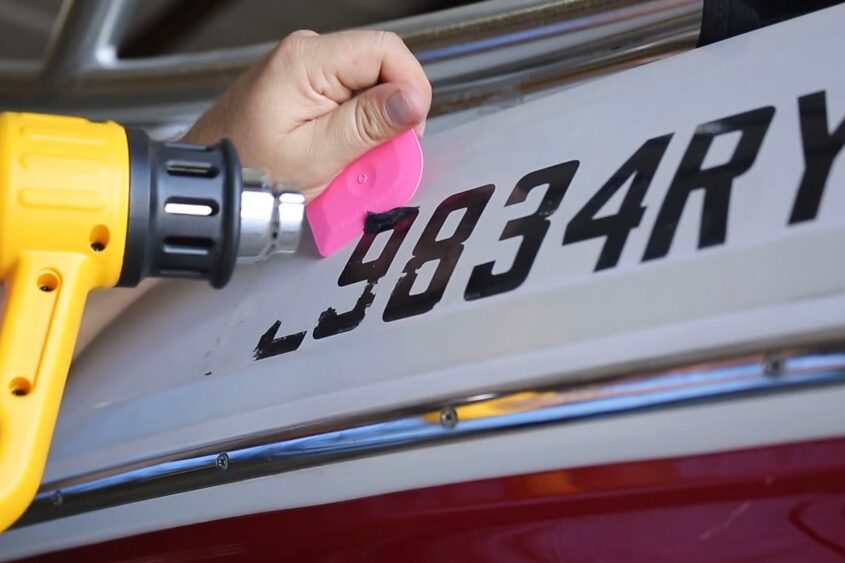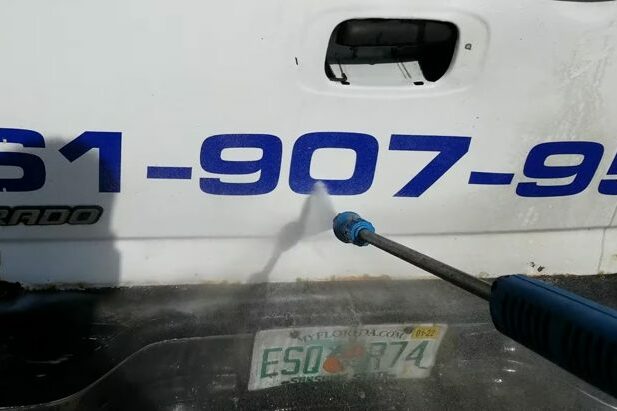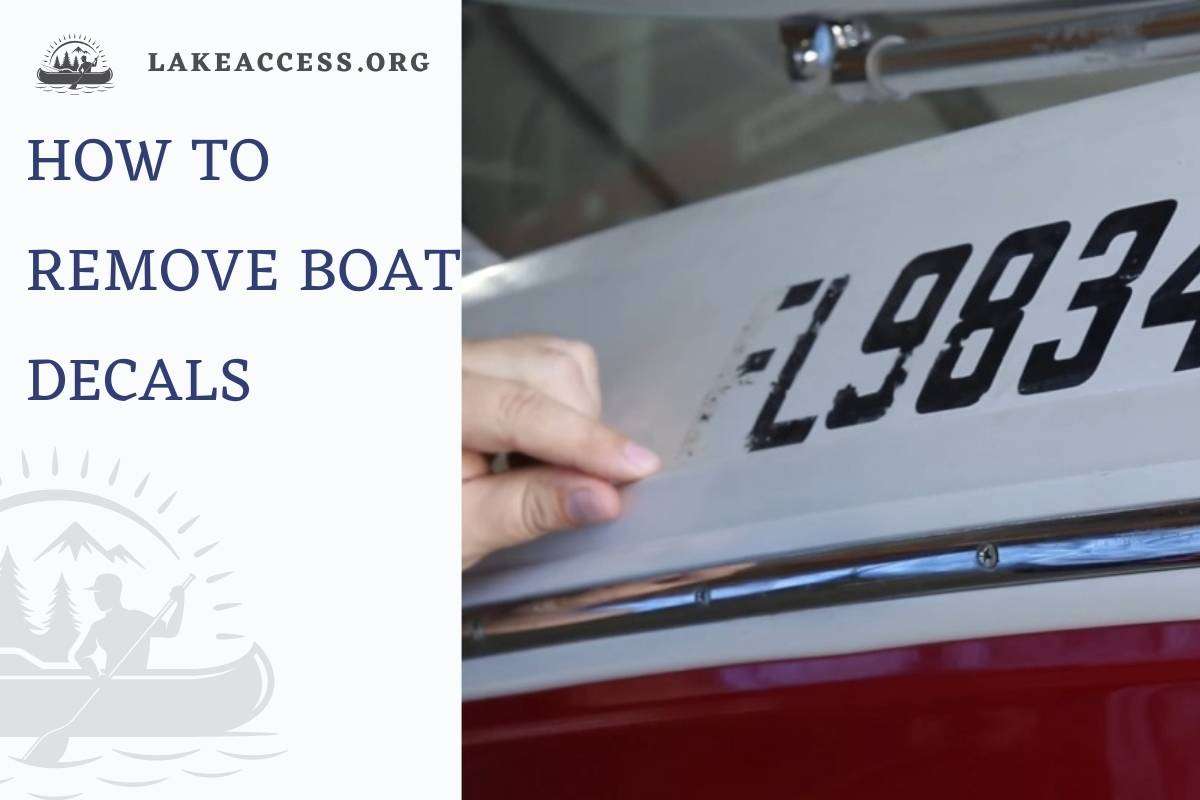If you’ve ever wondered how to give your beloved boat a fresh, new look or simply want to get rid of those outdated decals that have seen better days, you’re in the right place. In this comprehensive guide, we’ll walk you through the step-by-step process of removing boat decals, ensuring that your vessel not only sails smoothly but also looks its best. Say goodbye to those worn-out designs and hello to a sleek, pristine watercraft.
Preparing the Boat for decal removal
Before you embark on removing decals from your boat, it’s crucial to properly prepare the boat’s surface. This preparation ensures that the adhesive residue and vinyl particles are effectively removed, making the decal removal process much smoother and more efficient.
Step 1: Clean the Surface
The first step is to ensure the boat’s surface is clean and free from dirt, dust, or debris. Cleaning the surface is essential because it helps the adhesive residue and vinyl particles adhere better to the boat’s surface, making them easier to remove.
You can use a product containing solvents designed explicitly for removing adhesive residue and vinyl particles. These products are readily available and effectively prepare the surface for decal removal. Additionally, a razor blade or vinyl chipper is essential for scraping away decals without damaging the surface.
Step 2: Removing Old Paint Enamel (If Necessary)
A heat gun can be a valuable tool if your boat has remnants of old paint enamel from a previous boat name. Here’s how to use it:
- Apply oven cleaner to the areas with old paint enamel. The oven cleaner will cause the paint to bubble within a few minutes.
- After bubbling, use distilled vinegar to restore the gel coat to its original white color.
- Finish by polishing the surface with a window scraper, ensuring it’s smooth and ready for decal removal.
Effective Methods for Decal Removal
There are three main methods for removing boat decals, and each has its own set of advantages and considerations:
Method 1: Using an Eraser Wheel
The eraser wheel is a handheld tool with a rubber wheel designed to effectively remove adhesive residue. It is particularly useful for curved surfaces and is suitable for removing decals from boats, cars, and other vehicles. Here’s how to use it:
- Preparation: Before starting, ensure that no objects or surfaces near the decal could be damaged by heat. The eraser wheel can become hot during use.
- Clean the Surface: Use a small amount of rubbing alcohol to clean any dirt or grime from the area where you remove decals.
- Heat the Surface: Plug in the eraser wheel and let it heat up. Test the temperature by touching the eraser’s surface; it should be warm but not too hot.
- Remove the Decals: Use the eraser wheel to remove the decals from your boat’s surface. Work carefully and slowly to avoid damaging the boat’s surface.
- Scrape Away Remaining Decals: If there are any stubborn remnants, gently remove them with a plastic scraper or credit card, taking care not to scratch the boat’s surface.
- Clean Up: Use a clean rag or paper towel to wipe away any eraser residue. If you’ve used a solvent like acetone, wipe the area down with a clean rag before allowing it to dry.
- Allow Your Boat’s Surface to Dry: Let the boat’s surface air dry for a few hours before exposing it to water or applying new decals.

Method 2: Using a Heat Gun with a Scraper (Razor Blade)
This method is more aggressive and employs heat to soften the adhesive before scraping it off with a sharp blade. It’s suitable for flat surfaces and involves the following steps:
- Turn on the heat gun and hold it about 1 inch away from the decal.
- Hold a scraper or razor blade at a 45-degree angle against the decal.
- Move the heat gun and scraper in small circles until you have removed as much of the decal as possible.
- Turn off the heat gun and allow it to cool for a few minutes before attempting to scrape off any remaining adhesive with the scraper.
- Repeat the process on any other areas of decal adhesive that you wish to remove.
- Clean up any residue with a cloth or paper towel.
- Wash the area with soap and water to remove any remaining adhesive residue or decal glue from your boat’s hull.
- Allow the boat hull to dry completely before continuing with your project.

Method 3: Using a Hot Water Pressure Washer
This method is known for its speed and efficiency, and it can be used on various surfaces. However, caution must be exercised around electrical components or fuel tanks. Follow these steps:
- Fill a bucket with hot water and add a mild soap, degreaser, or all-purpose cleaner.
- Set the pressure washer to a low setting and spray down the area with the decal.
- Allow the cleaner to sit for a few minutes to break down the adhesive.
- Rinse the area with clean water to remove the cleaner.
- Apply a small amount of WD-40 to a paper towel and gently rub it into any remaining decal adhesive.
- Continue to apply WD-40 and rub until all decal adhesive is removed.
- Clean the area with soap and water to eliminate any remaining residue.
- Allow the area to dry completely before applying a new coat of wax or paint.

Cleaning Up After Decal Removal
Removing decals can be a messy process, but following these steps will help you clean up effectively:
- Use a solvent like acetone or nail polish remover to clean any residue from the boat. Apply the solvent to a clean rag and wipe away grime or glue until it is gone.
- Wipe down the area with soapy water and a bucket if needed. Wet the surface with soapy water, rinse it with fresh water, and then dry it thoroughly after cleaning.

What to Avoid When Removing Boat Decals
There are several things to avoid when removing boat decals to ensure a smooth and successful process:
- Excessive Force: Avoid using excessive force when scraping or peeling off decals, as this can damage the boat’s surface.
- Scraping at an Angle: Always scrape decals in a straight line rather than at an angle to prevent surface damage.
- Using Sharp Objects: Avoid using sharp objects other than recommended scrapers or blades, as they can gouge the boat’s surface.
- Not Protecting Surrounding Paint: Be sure to protect any painted surfaces around the decal removal area, as some methods can inadvertently damage paint.
- Touching Adhesive: Minimize contact with adhesive residue, as it can be challenging to remove from hands and clothing.
Troubleshooting Tips
If you encounter difficulties while removing boat decals, consider these troubleshooting tips:
- Ensure you’re using the correct solvent, such as acetone or fingernail polish remover.
- Use a clean rag to remove adhesive residue, not just water.
- Allow the boat to dry thoroughly before applying new decals.
- Be patient and take your time, especially with stubborn decals.
By following these comprehensive guidelines and tips, you’ll be well-equipped to tackle the task of removing boat decals effectively and with confidence. Whether you choose the eraser wheel, heat gun with a scraper, or hot water pressure washer method, proper preparation and careful execution are key to achieving the best results.
FAQs
What are some tips for removing boat decals quickly and easily?
There are a few things to keep in mind when removing boat decals. First, protect any painted surfaces around the area where the decals will be removed. Oven cleaners can remove the paint from the lettering, so it’s best to mask these off.
Secondly, use vinegar to return the gel coat to its original color. The vinegar will turn the gel coat yellow in some areas before leaving it white in others.
Finally, use a window scraper to remove the decals. Start with 400 grit, then 800, and finally, 3M super-duty rubbing compound. Finally, wet sand letters to remove them from the gel coat or polyurethane surface.
Removing boat decals takes patience and practice, but following these tips should help make the process easier!
What are the best products for removing boat decals?
There are a few different products that you can use to remove stickers from a fiberglass boat. The best two options are heat guns and erasers.
If you’re using a heat gun, keep the gun moving so that you don’t damage the fiberglass. Start by heating the sticker until it’s soft, then use an eraser or a scraper to remove it.
If you’re using an eraser, start heating the sticker until it’s soft. Then, use the eraser to rub off as much of the sticker as possible. Be careful not to damage the fiberglass while doing this.
What are some things to avoid when removing boat decals?
There are a few things to avoid when removing boat decals:
-Using too much force
-Scraping at an angle
-Using anything sharp other than a scraper blade or knife
These mistakes can cause the letters on the decal to come off in chunks, making removing all of the adhesives difficult. If this happens, you’ll likely need to use sandpaper or a drill to remove any remaining residue.

